Hanami (花見) is cherry blossom viewing in Japan. It is typically done by leisurely sprawling out on a picnic mat to admire the cherry blossoms.
Table of Contents
- What is Hanami? Hanami’s History and Origin Story
- How to do Hanami in Japan?
- What to bring, what to prepare for Hanami?
- What is Hanami Bento? What Hanami foods are there?
- 8 Famous Cherry Blossom Spots in Japan for Hanami
What is Hanami? Hanami’s History and Origin Story

Hanami (花見) means “flower viewing” in Japanese but has come to specifically refer to “cherry blossom viewing” in Japan.
When viewing other types of peoples, the pattern 〇〇見 (flower name + mi) or 観〇〇 (kan + flower name) is used instead. For example, 梅見 (Umemi) for “plum blossom viewing” and 観菊 (Kangiku) for “chrysanthemum viewing”.
Hanami’s History and Origins

Cherry blossoms have been the symbol of spring in Japan since a long time ago. Up till the Nara period, Hanami still carried the general meaning of “flower viewing” and included plum blossom viewing. But from the Heian period, when aristocrats held cherry blossom viewing banquets, Hanami came to specifically mean “cherry blossom viewing”.
Farmers would also hold Hanami as prayers to the Gods for a good harvest. There existed a belief that the God of Rice FIelds who resided in the mountains descends in spring and resides in the cherry blossom trees.
This also ties in with the origins of the word for cherry blossom, さくら (Sakura) - さ (Sa) representing the God of Rice Fields, and クラ (Kura) meaning “a place God resides”. Thus, “Sakura” means “the place where the God of Rice Fields resides”. There is also a theory that the blossoming of cherry blossoms that resemble rice flowers were used to predict the year’s harvest.
The Hanami would have food and drinks as hospitality to the Gods, and Hanami participants would enjoy each other’s company while they prayed for the year’s good harvest.
As for the common people, the custom of Hanami spread among them during the Edo period.
※ 暮らし歳時記, “花見の歴史”
Writer's Pick
How to do Hanami in Japan?
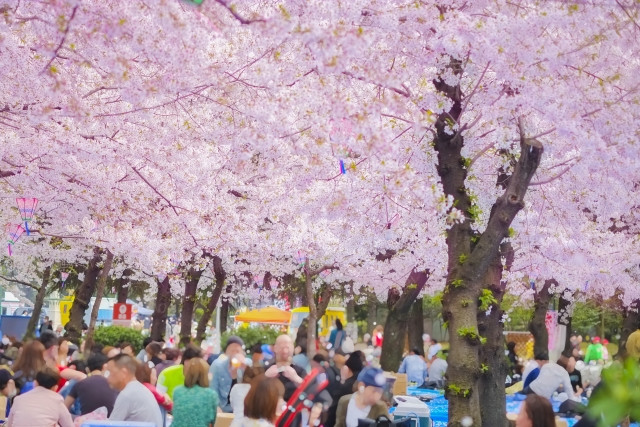
The standard way to do Hanami in Japan is picnic-style. A picnic mat is laid out in a park and food and drinks are enjoyed while admiring the cherry blossoms overhead. “Banquet (宴会, Enkai)” style Hanami is also often held, where people bring alcohol and alcohol snacks.
The Hanami and cherry blossom season coincides with Japanese companies’ season for fresh graduate employees and transfer employees joining the company, so many companies hold Hanami that also serve as social gatherings. Companies usually reserve Hanami spots in advance over a wide area in the park with large spread out picnic sheets and signage with the company’s name.
It is also common to admire cherry blossoms along rivers and roads while taking a walk or driving. You don’t need to reserve space or prepare food, so you can easily enjoy the cherry blossoms while out shopping or on a date.
What to bring, what to prepare for Hanami?
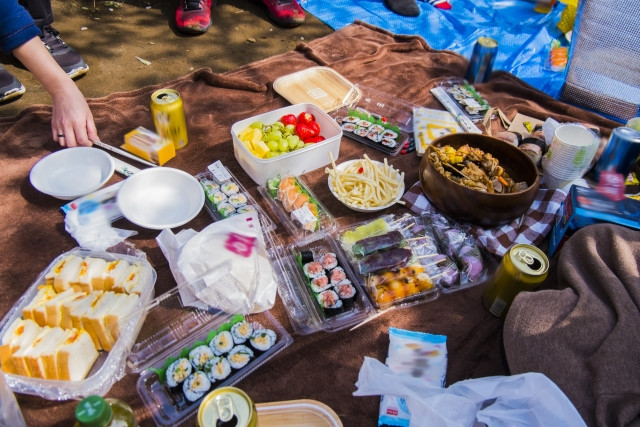
There is great fun to be had in preparing for Hanami itself - choosing the perfect Hanami spot, inviting family and friends, and planning the feast!
Hanami Spot
After deciding on where the Hanami will be held, double check if picnics are allowed there. Popular Hanami spots get really packed, to get a good spot under a cherry blossom tree requires going early.
Family & Friends
Coordinating tasks is an efficient way to ensure everything goes well. It is common to delegate the most important task of finding and reserving a Hanami spot to someone, while the rest of the group with their own tasks arrive later.
Other important tasks include preparing and bringing stuff that are required.
Things to Bring
Here’s a useful Hanami checklist on what you need.
- Picnic Mat (large enough for the group and belongings)
- [Optional] Cardboard underneath picnic mat for comfortable seating.
- Hanami Bento, Food and Drinks
- Disposable Utensils (plates, cups, chopsticks)
- Tissue & Wet Tissues
- Rubbish Bag (bring all your rubbish and waste back home with you for disposal; some parks have bins for disposal)
What is Hanami Bento? What Hanami foods are there?
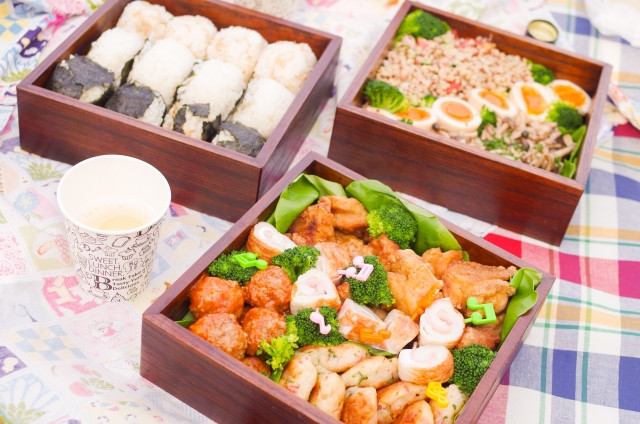
Hanami Bento (花見弁当), or O-Hanami Bento (お花見弁当), refers to the food eaten while doing Hanami. It is also called Kouraku Bento (行楽弁当), 行楽 (Kouraku) meaning “outing”, “excursion”, or “going on a picnic” in Japanese.
Although there are no rules as to what goes into a Hanami Bento, usually food that is delicious even when cold, looks pretty when served, and can be eaten in one bite is prepared.
Here are some standard Hanami foods to consider.
Sushi
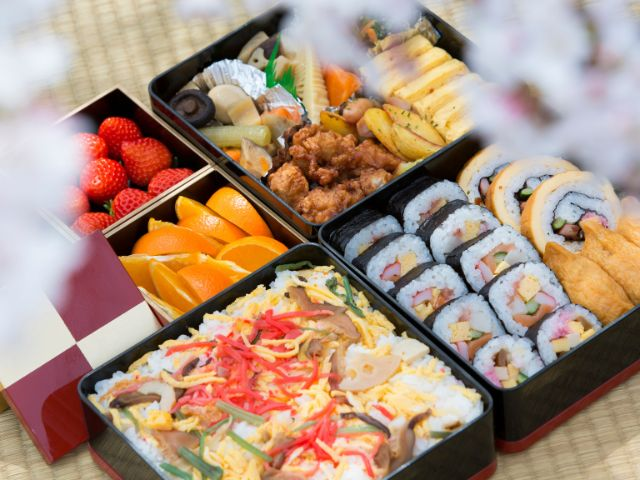
Sushi is indispensable for fun occasions like cherry blossom viewing. At a Hanami event where you spread out on a picnic mat, it is a good idea to eat inari sushi, maki sushi, temari sushi, etc.
Karaage
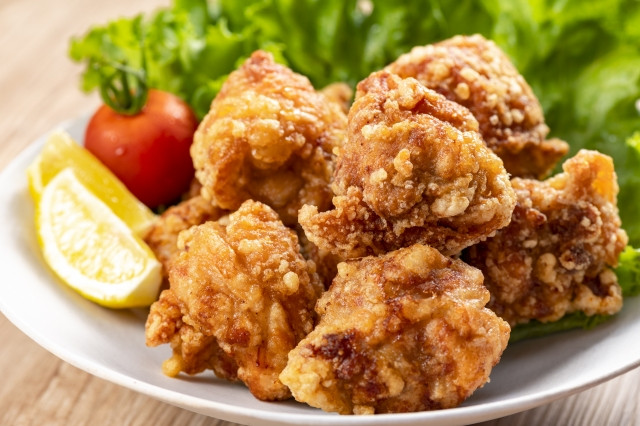
Karaage (fried chicken) is a standard side dish in bento (Japanese lunch boxes). If you use strong seasonings and lots of starch to the batter, it stays delicious even when cold.
Tamagoyaki
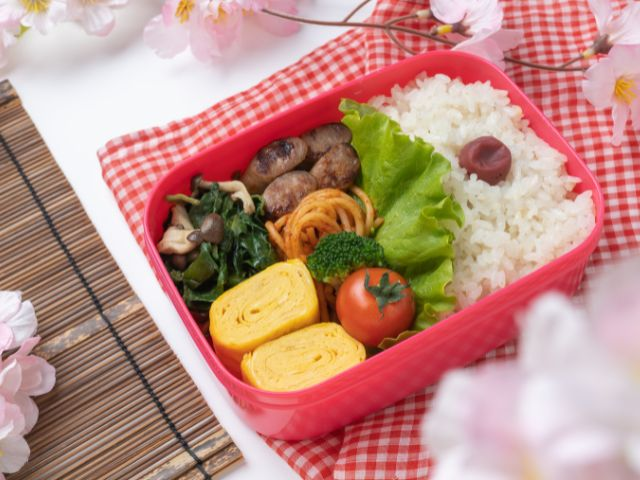
Tamagoyaki (Japanese rolled omelet) is another staple side dish in bento and one that everyone can enjoy. Salty or sweet, different people have different preferences for tamagoyaki, so we recommend preparing both if going Hanami with a group.
It would be fun to try making flower-shaped tamagoyaki in conjunction with cherry blossom viewing. It may seem difficult at first glance, but there are special tools sold in 100 Yen shops, or simply wrap the tamagoyaki with evenly spaced skewers in plastic wrap and let them sit for a while.
Onigiri
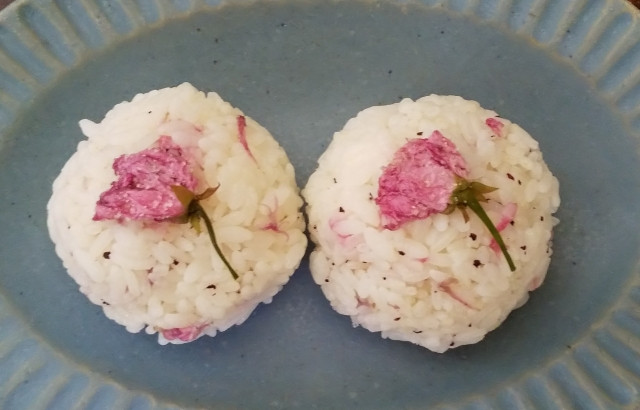
Onigiri (rice balls) are another favourite at Hanami as they are easy to make, keep, transport, and can be eaten with one hand. A variety of flavours can be prepared, such as ume (pickled plum), tuna mayonnaise, and salmon flakes.
To match the Hanami atmosphere, there is also Sakura Onigiri (cherry blossom rice ball) made with salted cherry blossoms that look pretty and also taste like cherry blossoms.
Sandwiches
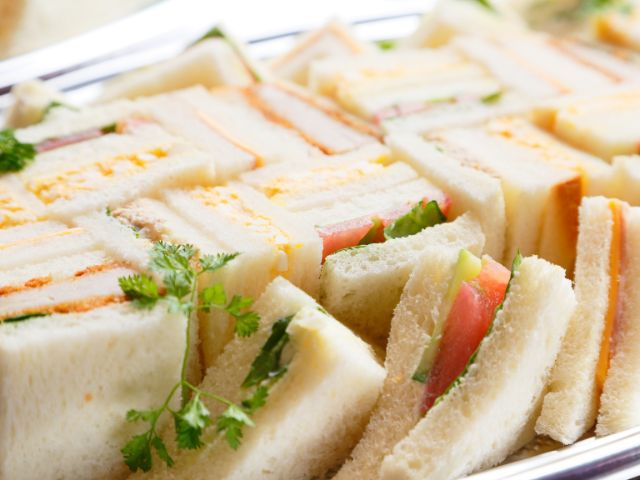
Standard Japanese sandwiches are egg sandwiches, tuna mayonnaise sandwiches, ham and cheese sandwiches, and BLT sandwiches. Filling ham cutlet and pork cutlet sandwiches are also popular.
Fruit sandwiches are growing popular these days. Fruit sandwiches are sandwiches filled with fresh cream and cut fruits, such as strawberries, mikan (mandarin oranges), and muscat. They look beautiful and are great as desserts.
French Fries or Potato Chips

Having French fries or potato chips as a side dish or snack appeals to both adults and children. By using frozen fries, you can save time on cooking. Try frying them by starting with cold oil, as they will stay crispy even after cooling down.
Potato chips are even more hassle-free, just buy big bags from the supermarket in different flavours.
Yakitori
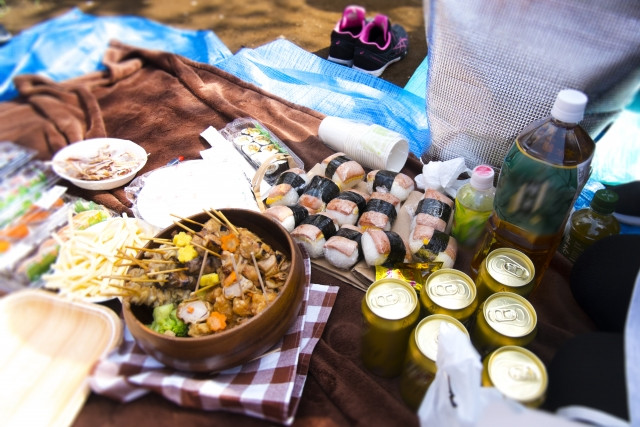
Banquet-style Hanami is usually accompanied by yakitori (chicken skewers) that goes well with alcohol, and can be eaten with one hand. Thigh (もも, momo), skin (鶏皮, torikawa), and chicken balls (つくね, tsukune) are popular. For a variety of different yakitori, it is convenient to use take-out services such as food stalls or yakitori specialty restaurants.
Hanami Dango
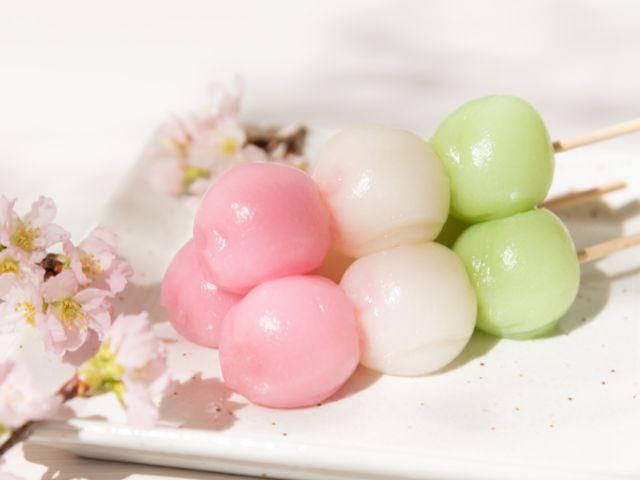
When it comes to Hanami desserts, you can’t miss out on Hanami Dango. Hanami Dango comes in three colours - pink, white and green. There are various theories as to why the colours are fixed.
Theory ① : Pink = Spring, White = Winter, Green = Summer
There is no representation of autumn based on the pun「飽きがこない (Aki ga Konai」meaning “you won’t get sick of it” = 「秋がこない (Aki ga Konai」”autumn won’t come”.
Theory ② : Pink = Cherry Blossom, White = Residual Snow, Green = Grass Beneath the Snow
Hanami Dango signifies the arrival of spring.
Sakura Mochi
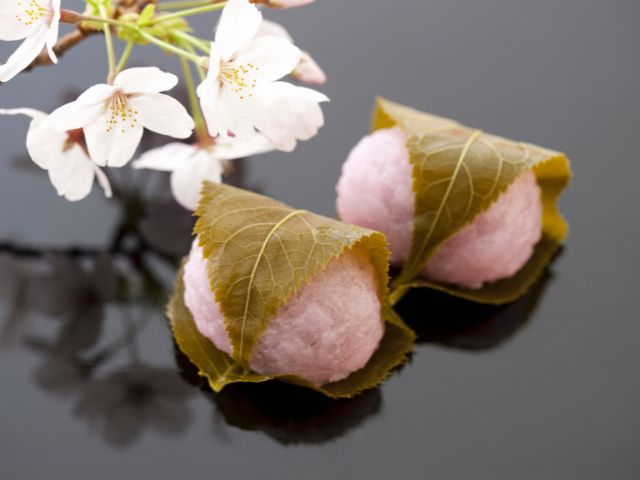
Sakura Mochi, rice cake wrapped in salted cherry leaves, is a classic traditional Japanese sweet eaten during Hanami. There are two types of Sakura Mochi - Kansai-style and Kanto-style.
Kansai-Style Sakura Mochi
Kansai-Style (道明寺, Domyoji) is made by wrapping sweet red bean paste in dough made from coarsely ground glutinous rice, similar to Ohagi.
Kanto-Style Sakura Mochi
Kanto-Style (長命寺, Choumeiji) is made with strained red bean paste wrapped in thin dough made from steamed wheat flour.
Opinions are divided between those who eat the salted cherry leaves with the Sakura Mochi, and those who peel them off and don’t eat them.
Buy Hanami Bento

If handmade Hanami Bento is too difficult, a good idea is to buy Hanami Bentos from stores. Every year, gorgeous Hanami Bento are sold at Depachika (department store’s food basement area) and Japanese restaurants. Many restaurants require advance reservations, so if there’s a Hanami Bento you are interested in, check and reserve in advance.
8 Famous Cherry Blossom Spots in Japan for Hanami
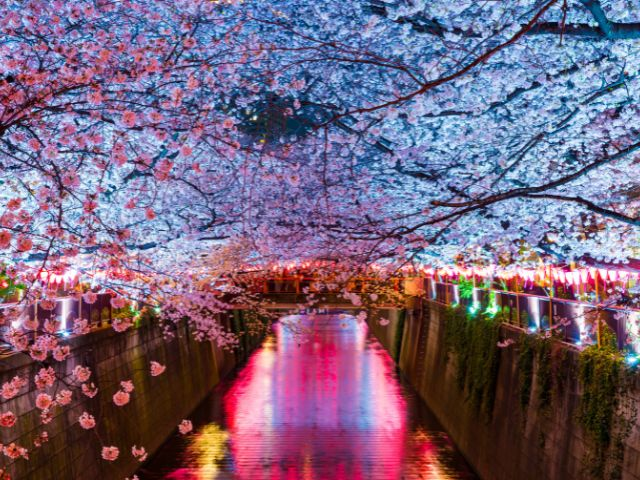
For those who want to go Hanami but aren’t sure where to go, we’ll introduce some famous Hanami spots.
1. [Hokkaido] Goryokoku Park

Goryokaku Park (五稜郭公園) in Hakodate City, Hokkaido is a park created by maintaining the Goryokaku Ruins, one of only two star-shaped first in Japan. The star-shaped view of cherry blossoms seen from the observatory deck in the adjacent Goryokaku Tower cannot be seen anywhere else.
2. [Aomori] Hirosaki Park
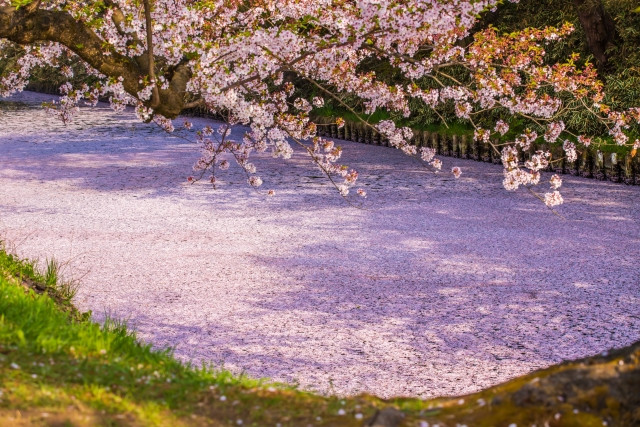
Hirosaki Park (弘前公園) in Hirosaki City, Aomori Prefecture is one of Japan’s three major cherry blossom spots. The cherry trees are provided with the same care as apple trees, Aomori’s specialty, resulting in impressive voluminous blooms.
The Hirosaki Cherry Blossom Festival is held every year during the cherry blossom season. You can enjoy cherry blossom viewing from a boat or sightseeing cruise.
3. [Nagano] Takato Castle Ruins Park
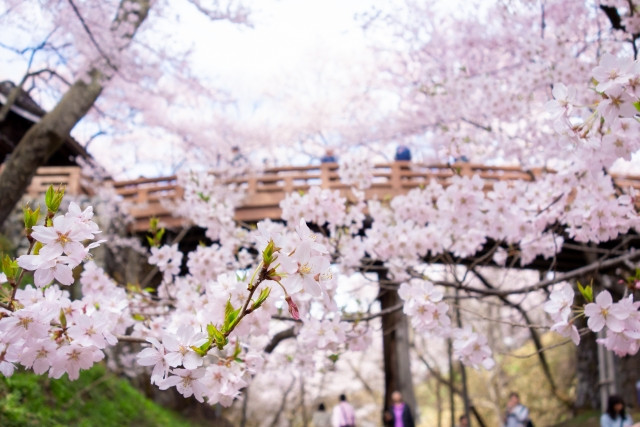
Takato Castle Ruins Parks (高遠城址公園) in Ina City, Nagano Prefecture is one of Japan’s three major cherry blossom viewing spots. It is known for its “Takato Ohiganzakura”. Takato Ohiganzakura is smaller and has darker pink petals than Somei-Yoshino, which is commonly seen in Japan. The cherry blossoms in Takato Castle Ruins Parks are called「天下第一の桜 (Tenka Daichi no Sakura」- “The Best Cherry Blossoms in the World” due to their beauty and large numbers.
4. [Tokyo] Meguro River
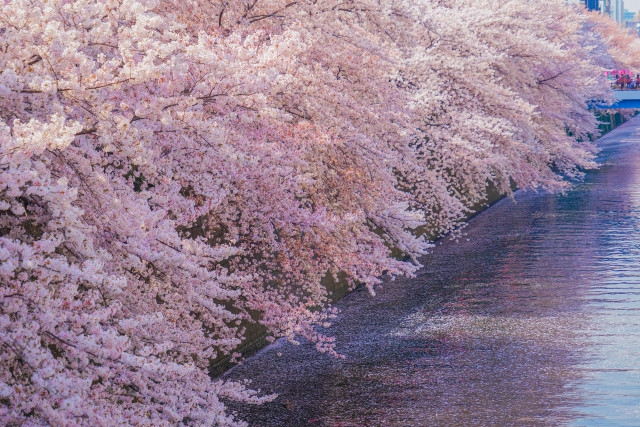
Along the Meguro River (目黒川), which flows through Meguro Ward, Tokyo, Somei-Yoshino cherry trees in full bloom are lined up, filling the river with their petals. Particularly famous spots along the river are from Ikejiri Ohashi Station on the Tokyu Denentoshi Line to Meguro Station on the Tokyu Meguro Line.
There are many stylish cafes and restaurants along the Meguro River offering limited cherry blossom themed menus during the Hanami season. Enjoy a meal or tea while admiring the cherry blossoms. As one of the most popular cherry blossom viewing spots in Tokyo , the area gets very crowded, so make sure to reserve in advance.
5. [Tokyo] Shinjuku Gyoen

Shinjuku Gyoen (新宿御苑) is one of Japan’s and Tokyo’s most famous Hanami spots. The wide and spacious park with numerous cherry blossom trees has space for hundreds of people to hold Hanami picnics. Alcohol is prohibited in Shinjuku Gyoen, so everyone can enjoy the cherry blossoms in peace and quiet.
6. [Osaka] Osaka Castle Park
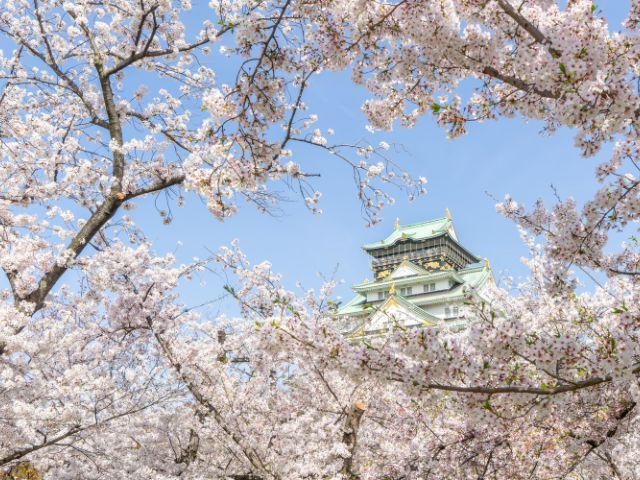
Osaka Castle Park (大阪城公園) is a popular Hanami spot in the Kansai region. The park is divided into several areas, the view of cherry blossoms and Osaka Castle Tower from the Nishinomaru (西の丸) area is especially beautiful. There are also museum and shop facilities inside the castle tower, so you can enjoy sightseeing in addition to cherry blossom viewing.
7. [Nara] Mount Yoshino
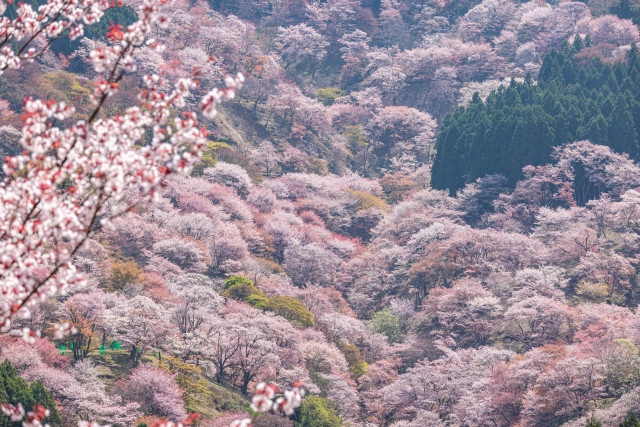
At Mount Yoshino (吉野山) in Yoshino City, Nara Prefecture, you can admire the 30,000 cherry trees in full bloom that cover the entire mountain. This impressive scenery, considered one of Japan’s three major cherry blossom viewing spots, is also recommended for those who are tired of cherry blossom viewing in parks. The cherry trees bloom in order from the bottom to the top of the mountain, so it can be enjoyed for a long period of time.
8. [Kyoto] Maruyama Park
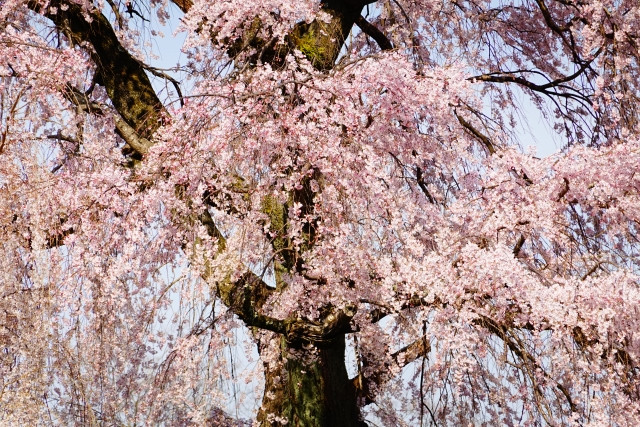
Maruyama Park (円山公園) in Higashiyama Ward, Kyoto Prefecture is the most popular Hanami spot in Kyoto, especially for Hanami picnics in early April. During the evening, its centrepiece Shidarezakura (weeping cherry blossom tree) is illuminated. Maruyama Park is located right behind Yasaka Shrine (八坂神社) and near the Gion area, so you can sightsee after enjoying the cherry blossoms.
To Close
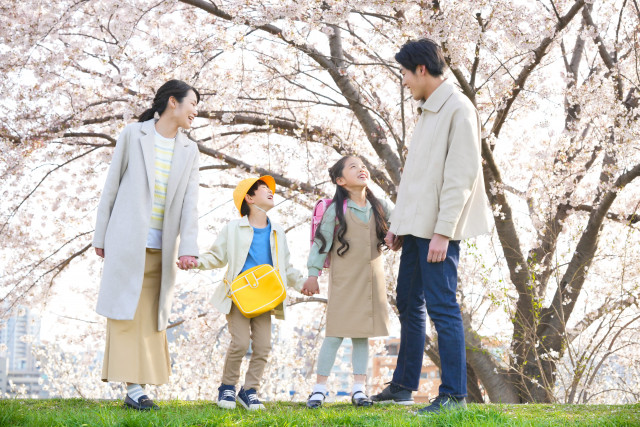
The cherry blossom season in Japan is one of the most highly-anticipated by locals and overseas tourists alike. Now that you know about Hanami and how it is done, you can truly experience cherry blossoms the way the Japanese do. We highly recommend enjoying Hanami banquet-style or picnic-style, it’s truly a unique and unforgettable experience.















.jpg)

















